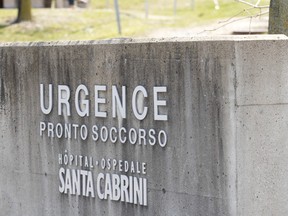Under the Charter of the French Language, certain designated hospitals can provide “services to persons who, in the majority, speak a language other than French.”

Under section 29.1 of the Charter of the French Language, certain designated municipalities, school boards and institutions — including hospitals — can provide “services to persons who, in the majority, speak a language other than French.”

That date was critical, as it was months before Bill 10, a sweeping reform of the health system, was to take place under the former Liberal government. When Bill 10 took effect on April 1, 2015, new regional health agencies assumed management over a host of designated bilingual medical facilities.
These regional health agencies, known by their French abbreviations of CIUSSS and CISSS, still exist today. But only two of them, the CIUSSS de l’Ouest-de-l‘Île-de-Montréal and the CIUSSS du Centre-Ouest-de-l’Île-de-Montréal, are listed by the OQLF as having bilingual status, among only 10 other health institutions. By comparison, the list that was published in 2014 included 39 designated bilingual health institutions.
But Maldoff insisted Santa Cabrini and other health institutions that were on the list of 2014 still enjoy their bilingual status today. And this is where the other government department comes in, the Health Ministry, which appears to back up Maldoff’s assertion with two lists of its own.
This is what the Health Ministry on its website states about the first of its two lists:
“Institutions and facilities that are designated are required to make all their health and social services available in English to English-speaking people. They have been designated by the government and are recognized under section 29.1 of the Charter of the French Language as offering a majority of their services to English-speaking people.”
That list designates 69 public and private health institutions as offering services to English-speaking Quebecers across the province, including Jeffery Hale — Saint-Brigid’s hospital in Quebec City; the CLSC Donald-G.-Hodd in the Côte-Nord; in the Eastern Townships, the Institut universitaire de gériatrie de Sherbrooke; in the Laurentians, the Résidence de Lachute; the Hôpital juif de réadaptation in Laval; the Ormstown CHSLD in the Montérégie; and the Wakefield Memorial Hospital in the Outaouais, among others.
What’s more, the Health Ministry states in the preamble to its second list “people from ethnocultural communities can have access to health and social services that respect their ethnocultural and linguistic reality. Various measures are in place to ensure and improve the accessibility of services offered to these people.
“Interpreting and translation services are available in some regions,” the statement adds. “These services enable people who are not sufficiently fluent in French or English to understand and be understood by health-care professionals. Interpreters improve and facilitate verbal and cultural communication between health-care professionals and patients.”
And Santa Cabrini is found on that second list, as well as the Hôpital chinois de Montréal, CHSLD Dante and CHSLD Polonais Marie-Curie Sklodowska. “These institutions offer health and social services in French, but also in other languages,” according to the statement.
So it would appear these two lists clear things up. Except they don’t. That’s because they are not officially included in the list by the OQLF.
And even if they were, the new language directive issued by the Health Ministry on July 18 would appear to take precedence over even designated bilingual institutions, permitting English and other languages to be uttered in only exceptional situations — for example, after a 14-year-old girl has had an abortion and her aunt needs a medical checklist in English.
In the meantime, the OQLF — which visited Santa Cabrini earlier this week to check whether some of the U.S.-made medical equipment and instruction manuals in its operating rooms were in French — will continue to tour other hospitals to ensure they conform to the language charter.